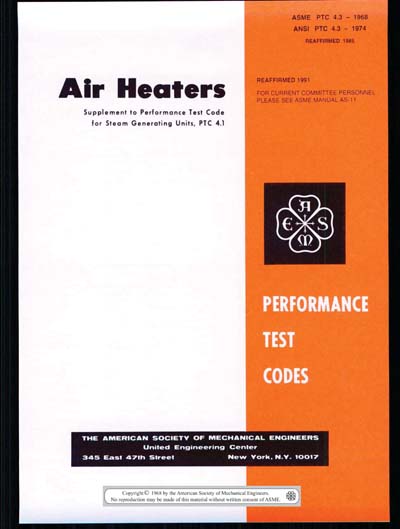Historical
ASME PTC 4.3-1968 (R1991)
Air Heaters (PTC 4.3 - 1968)
The purpose of this Code is to establish procedures for conducting performance tests to determine: Gas side efficiency; Air leakage; Other related operating characteristics such as: X-Ratio; Gas and air pressure loss; Gas and air temperature; A determination of any or all of the performance items specified above may be necessary for: Checking the actual performance against the manufacturer's guarantee; Comparing these items with a standard of operation; Comparing performance when firing different fuels; Determining the effect of changes to equipment; Determining corrections to air heater exit gas temperature caused by variations in inlet air temperature in an efficiency test of a steam generator. Obtaining any other pertinent information required. This Code applies specifically to the regenerative and tubular type air heaters. It also applies to any combustion gas-to-air heat exchangers used in conjunction with a steam generator. For the purpose of this Code, the air heater is defined as a heat exchanger used to transfer heat from gases of combustion to combustion air without the use of an intermediate heat transfer fluid. Specifically excluded are the supplementary steam coil air heater, direct fired air heater and low temperature economizer. However, a separate low temperature air heater would be considered part of the air heater installation. If the installation consists of more than one air heater in parallel, all air heaters are included as a unit. However, if the air heaters are in series and have other apparatus in between, then each air heater, or each group of parallel air heaters, shall be tested individually.
American Society of Mechanical Engineers [asme]

